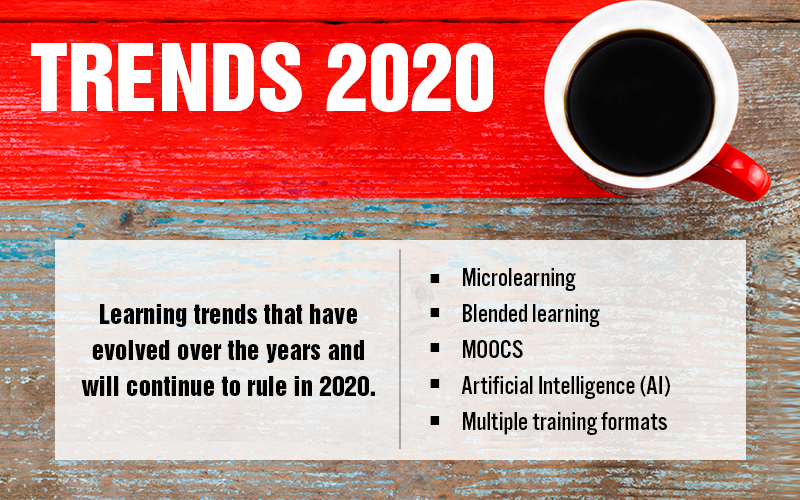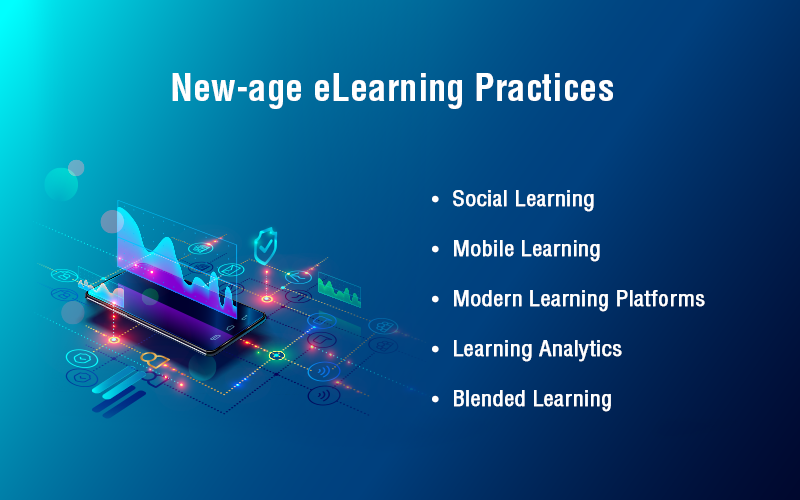5 eLearning Trends to Look Out for in 2020

We’re all ready to begin the new year in a few weeks! Are you eagerly looking for new things to implement in online training? How are you going to find them? Continue reading this blog to find out what’s all the rage in eLearning. E-learning, like most technology, keeps evolving (for the good), bringing better things to the training table every year.
What are the Top 5 eLearning Trends for 2020?
- Microlearning for visitor training
- Blended learning for onboarding
- MOOCs for corporate training
- Artificial Intelligence to save translation cost
- Multiple training formats for flexiiblty
So, if you’re a training manager eager to know all about the latest trends in eLearning, you are in the right place. Check out some of these eLearning trends.
Before that, give this mini guide on rapid eLearning design a read.
5 Hot Picks of eLearning Trends for 2020
1. Microlearning for Visitor Training
You’ve been planning and organizing training for your employees with instructor-led training (ILT) or eLearning. But, you obviously cannot use the same training methods for your clients, visitors, and suppliers. Which is why microlearning is your best bet! It won’t take too much of their time, and is easily updated, reused, or repurposed.

Don’t forget, each microlearning module aims to convey information on a single topic since it’s focused on one learning objective per module. So how do you use microlearning to train visitors (such as clients, vendors, and customers) to your facility on a particular topic? Here are a few ideas:
- Send microlearning videos to your visitors to access and go through them before coming to the site, reducing on-site training time.
- Use microlearning assets (instead of printed manuals) to welcome first-time visitors and introduce them to your organization’s culture.
- Use microlearning videos or infographics to train them on layouts in risk-prone environments.
This trend will surely help cut down on time and costs, and of course, make an enormous impact on your visitors!
2. Blended Learning for Onboarding
Employee satisfaction and retention depend a lot on how your newly hired employees receive their onboarding training. According to Gallup, only 12% of employees believe their organizations do a great job onboarding new employees, and according to the Society for Human Resource Management (SHRM), as many as 50% of employees put in their papers in the first 18 months of employment. This can prove very expensive, both in terms of cost and resources, affecting a company’s financial bottom line.
That means your onboarding training should hit the spot every time, keeping your learners engaged and happy. This can put a lot of pressure on you, as a training manager. All that time, effort, and cost will be for naught if your learners are left bored or overwhelmed at the end of training. So, how can you ensure this does not happen with your onboarding?
Blended learning! It’s one of the exciting trends for 2020 that will make your employees stick to training. Blended learning combines different training formats so you can use your classroom training’s engagement and the anytime, anywhere learning benefit of mobile learning to make onboarding powerful.
- You can begin with the digital format – for instance, you can send your new hires videos of an overview of your company and its culture, along with a message from the CEO. This way, employees will feel welcome even before they join the organization.
- You can use the classroom to train them on work processes. Face-to-face interactions with the instructor will give them opportunities to quickly clear their doubts.
- Since it is almost impossible for them to remember all the learning in one go, you can use microlearning assets such as infographics and videos to reinforce what they learned.
So, go ahead and use blended learning the next time you plan onboarding to your new hires.
3. MOOCs for Corporate Training
Classroom training, eLearning, and blended learning are not the only options you have in your training arsenal to train your employees. What about when you are hard-pressed for time and budgets? What would you do then? Would you want to go through the hassle of developing a whole new training program with such constraints?
No! What you can do is follow this growing trend of MOOCs (Massive Open Online Courses), an open learning platform that offers online courses on several topics. You can use MOOCs to train employees on:
- Mandatory topics such as Prevention of Sexual Harassment (POSH)
- Courses on Excel or basic management and skills that are readily available online
That’s another trend of 2020 for you to incorporate in your organization to stay in the race!
4. Artificial Intelligence (AI) to Save Translation Cost
Saving costs here means saving time as well, because time saved is money earned. How does artificial intelligence do this? Let’s first talk about the traditional method of translating eLearning – outsourcing to organizations offering translation services. These organizations need a lot of time to transcribe and record the audio for the translated course. All this effort surely takes time. .
But AI-driven machines translate the same number of words in a much shorter time. AI-enabled translations might not do a perfect job, but you can let human translators and linguists do a final check after AI has done its work.
- Translators will just have to make minor changes after the AI-enabled program does a rough translation of the content, saving you large amounts of time in the process.
- AI also uses predictive typing functions and vocabulary suggestions from previously translated content, as it learns from previous experiences, making its output more precise.
If you have a globally dispersed employee workforce, this trend can prove to be very advantageous for you. You may not want to rely entirely on AI for eLearning translations, but using it at least for the first cut of translation will save you a lot of time and costs.
5. Multiple Training Formats for Flexiblity
Just as you wouldn’t like to use a single-language course to train your globally dispersed workforce of different backgrounds, cultures, age groups, and languages, you shouldn’t be using the same training format for everyone. The ‘one-size-fits-all’ philosophy doesn’t work, unless learner engagement or the impact of training on your learners doesn’t matter to you. So, what you have to do is use different training formats to cater to different employees.
- Use videos to train busy employees, so they don’t have to spend a lot of time in training (videos convey a lot in very little time).
- Use downloadable PDFs for employees who are constantly on-the-move. This will be very handy for them, as they do not have to depend on the LMS (Learning Management System).
Follow this trend and provide your learners training in whichever format they prefer. You will then see its benefits through the impact of training on your business performance.
Wrapping it up!
These were just some of the eLearning trends high-performing organizations have been using and reaping the benefits of. Don’t you also want to enjoy the same benefits? You don’t need to implement all these trends, a few will do to make your training a success! So go ahead and use them in your next corporate training solution.
These eLearning trends for 2020 are not limited to these 5. There are more, many more that I cannot talk about now. You can access them through our free eBook. Download the eBook given below to know more about these trends.
Editor’s note: This post was originally published in December 2019 and has been updated for comprehensiveness.





![Gear Up for 2023! eLearning Trends for the Year [Webinar]](https://blog.commlabindia.com/hubfs/Imported_Blog_Media/elearning-trends-2023-a-view-from-the-trenches-webinar.png)